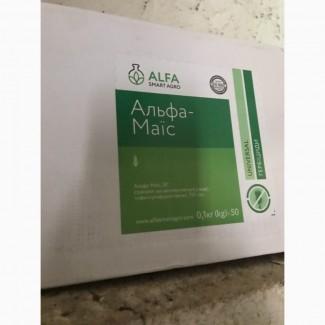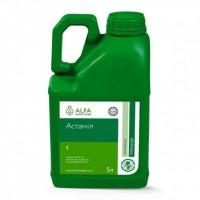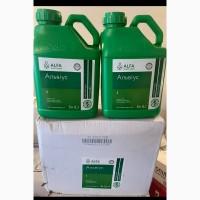/ Fertilizers and plant protection products / Herbicides / Alfa-Mais - a herbicide for the destruction of weeds...
For sale / buy
Alfa-Mais - herbicide for the destruction of weeds in crops of corn, soybeans, winter wheat, Kyiv region.
Price10$
Region:all Ukraine,
Kyiv region.
(Vyshhorodok)
Updated:
Alfa-Mais - Systemic post-emergence herbicide for the destruction of annual dicots, incl. resistant to 2,4-D, weeds
Active substance: Thifensulfuron-methyl 750 g/kg
Formulation: Water-dispersible granules
Manufacturer: Alfa Smart Agro
Packaging: a box of 50 pieces of 100 g, the price is for 100 g.
Method of application and rates of consumption: Culture Objects Consumption rate of the drug, g/ha Processing method Maximum number of treatments
Corn
One-year dicots, incl. resistant to 2.4 D, weeds 10–15* In the phase of 3–5 leaves of culture 1 Preparations with an identical active substance are used on the following cultures
Soy
Annual dicots, including resistant to 2.4 D. weeds 6-8 + PAR Alfalip (0.1 l/100 l of water) Spraying in phase 1-2 true leaves of the crop (at the early stages of weed development) 1
(//tractor-service.com)
Winter wheat
15 – 20 +PAS Alfalip (0.1l/100l of water) Spraying of crops, starting from the phase of 2-3 leaves until the end of tillering of the culture Spring barley 10 –15 +PAS Alfalip (0.1l/100l of water)
Londovgunets
15–25** Crop spraying in the "herringbone" phase *Alfa-Mais, 10 g + Alfalip surfactant, 0.1 l/100 l of water, or Alfa-Mais, 15 g without Alfalip surfactant. ** it is not recommended to use surfactants on flax crops.
Advantages of Alfa-Mais herbicide:
High systemicity allows the drug to quickly move to the growth zones of roots and shoots.
Having a specific mechanism of action on the enzyme system of weeds, it affects them after a few hours.
There are no restrictions on crop rotation, it decomposes quickly in the soil, the half-life is 6 days.
It is possible to use in tank mixtures with various fungicides, insecticides and herbicides, but in each case the preparations should be checked for compatibility. High efficiency against the most harmful dicotyledonous weeds.
General recommendations:
The highest effectiveness of the drug is observed when spraying annual weeds in the phase of 2-4 leaves. To increase the herbicidal effect of Alfa-Mais, it is necessary to use surface-active substances (surfactant Alfalip, 0.1 l/100 l of water). Not recommended for use on parent lines ofmaize, sweet corn for popcorn. Do not use in a tank mix with organophosphorus insecticides and do not apply within 14 days before or after treatment with organophosphorus insecticides. Treatment with graminicides should be carried out no earlier than 5 days after application. Do not process crops during periods of stress (cold or hot weather). Do not use Alfa-Mais in a tank mix with imazetapyr-based herbicides or after spraying soybean crops with these drugs.
Recommended tank mixes for corn crops: Alfa-Mais (10 g/ha) + Alfa-Dicamba (0.3-0.4 l/ha) + Alfalip surfactant (0.1 l/100 l of water); Alfa-Mais (10 g/ha) + AlfaEther (0.4-0.5 l/ha) + Surfactant Alfalip (0.1 l/100 l of water); Alpha-Mais (10 g/ha) + Ramses (40-50 g/ha) + Alfalip surfactant (0.1 l/100 l of water), Alpha-Mais (6 g/ha) + Alpha-Bentazon (1.5-2.0 l/ha); with heavy clogging by white quinoa: Alfa-Mais (10 g/ha) + Clinch Forte (50 g/ha) + PA Booster (0.1 l/ha). Mechanism of action of Alpha-Mais Alpha-Mais stops the division of weed cells by affecting their enzyme system. Inhibits the enzyme ALS (acetolactate synthetase) and stops weed growth a few hours after application. In sensitive weeds, it causes cessation of growth, chlorosis, death of growth points, necrosis and complete death. More resistant weeds or those in a later stage of development at the time of treatment may stop growing during the growing season, but they no longer compete with cultivated plants. It acts mainly through the leaf surface of plants. Visible symptoms appear 3-7 days after use. The death of sensitive weeds can last 10-20 days. Sensitive - veronica (species), triple hibiscus, triple mustard, birch mustard, amphibious mustard, renal mustard, nodular mustard, field mustard, netreba (species), medium star, Theophrastus' rope, gill (species),sunflower 2-4 leaves), garden purslane, wild radish, chamomile (species), cow's milk, violet (species), styrus, nettle (species), marigolds, marigold, common spergel, dry rib medicinal, sorrel species), deaf nettle, common sorrel, dog roman, dandelion, rapeseed rape, bitter gorse (argue). Moderately sensitive - field and yellow thistles, rutabaga, wild poppy, bitter gorse, common yellowwort, ragweed (2 leaves), scotland, common dorsum, one-year heather, broad quinoa, white quinoa. Resistant and insensitive - field birch, milk thistle (species), small-flowered galinsoga, black solanum. Properties of the herbicide Spectrum of action: sensitive - veronica (species), hibiscus trifolium, mustard trifoliate, bitter mustard, bitter mustard, amphibious mustard, kidney mustard, nodular mustard, field mustard, netreba (species), medium star, Theophrastus' rope, gill (species), bitter gorse, sunflower (fall 2-4 leaves), garden purslane, wild radish, chamomile (species), henbane, violet (species), sedum, nettle (species), marigolds, marigold, common spergel, dry rib medicinal, sorrel species), deaf nettle, common sorrel, common sedge, dogwood, dandelion, rapeseed rape, common mustard; moderately sensitive - field and yellow thistles, rutabaga, wild poppy, tenacious nightshade, common yellowwort, ragweed (2 leaves), scotch-like scotch, common sedum, one-year sedge, broad-leaved quinoa, white quinoa; resistant and insensitive - field birch, milk thistle (species), small-flowered glainsoga, black nightshade. The working fluid consumption rate is 200–300 l/ha. Harmful objects destroyed by Alpha-Mais Galeopsis tetrahit L. Rowan sorrel - Rumex acetosella L. Garden purslane - Portulaca oleracer L. Common sedge - Lepidium (Cardaria) draba (L.) Desv. Amaranthus retroflexus L. Field violet - Viola arvensis Murr. Spergel ordinary - Spergula arvensis L. Medicinal turnip - Fumaria officinalis L. Tririberbium unscented, chamomile unscented - Matricaria perforata Merat. Common spore or Common bitter gourd - Polygonum aviculare L. Field mustard - Sinapis arvensis Field thalamus - Thlaspi arvense L. Wild radish - Raphanus raphanistrum L. Galinsoga small-flowered - Galinsoga parviflora Cav. Acroptilon repens (L.) DC. Crepis tectorum L. Dandelion - Taraxacum officinale Wigg. Canadian sedge - Erigeron canadensis L. Stinging nettle - Lamium amplexicaule L. Stinging nettle - Galium aparine L. Wild hemp - Cannabis ruderalis Janisch Black mustard - Brassica nigra L. (synonym — Sinapis nigra) Descurainia Sophia (L.)Schur.
Active substance: Thifensulfuron-methyl 750 g/kg
Formulation: Water-dispersible granules
Manufacturer: Alfa Smart Agro
Packaging: a box of 50 pieces of 100 g, the price is for 100 g.
Method of application and rates of consumption: Culture Objects Consumption rate of the drug, g/ha Processing method Maximum number of treatments
Corn
One-year dicots, incl. resistant to 2.4 D, weeds 10–15* In the phase of 3–5 leaves of culture 1 Preparations with an identical active substance are used on the following cultures
Soy
Annual dicots, including resistant to 2.4 D. weeds 6-8 + PAR Alfalip (0.1 l/100 l of water) Spraying in phase 1-2 true leaves of the crop (at the early stages of weed development) 1
(//tractor-service.com)
Winter wheat
15 – 20 +PAS Alfalip (0.1l/100l of water) Spraying of crops, starting from the phase of 2-3 leaves until the end of tillering of the culture Spring barley 10 –15 +PAS Alfalip (0.1l/100l of water)
Londovgunets
15–25** Crop spraying in the "herringbone" phase *Alfa-Mais, 10 g + Alfalip surfactant, 0.1 l/100 l of water, or Alfa-Mais, 15 g without Alfalip surfactant. ** it is not recommended to use surfactants on flax crops.
Advantages of Alfa-Mais herbicide:
High systemicity allows the drug to quickly move to the growth zones of roots and shoots.
Having a specific mechanism of action on the enzyme system of weeds, it affects them after a few hours.
There are no restrictions on crop rotation, it decomposes quickly in the soil, the half-life is 6 days.
It is possible to use in tank mixtures with various fungicides, insecticides and herbicides, but in each case the preparations should be checked for compatibility. High efficiency against the most harmful dicotyledonous weeds.
General recommendations:
The highest effectiveness of the drug is observed when spraying annual weeds in the phase of 2-4 leaves. To increase the herbicidal effect of Alfa-Mais, it is necessary to use surface-active substances (surfactant Alfalip, 0.1 l/100 l of water). Not recommended for use on parent lines ofmaize, sweet corn for popcorn. Do not use in a tank mix with organophosphorus insecticides and do not apply within 14 days before or after treatment with organophosphorus insecticides. Treatment with graminicides should be carried out no earlier than 5 days after application. Do not process crops during periods of stress (cold or hot weather). Do not use Alfa-Mais in a tank mix with imazetapyr-based herbicides or after spraying soybean crops with these drugs.
Recommended tank mixes for corn crops: Alfa-Mais (10 g/ha) + Alfa-Dicamba (0.3-0.4 l/ha) + Alfalip surfactant (0.1 l/100 l of water); Alfa-Mais (10 g/ha) + AlfaEther (0.4-0.5 l/ha) + Surfactant Alfalip (0.1 l/100 l of water); Alpha-Mais (10 g/ha) + Ramses (40-50 g/ha) + Alfalip surfactant (0.1 l/100 l of water), Alpha-Mais (6 g/ha) + Alpha-Bentazon (1.5-2.0 l/ha); with heavy clogging by white quinoa: Alfa-Mais (10 g/ha) + Clinch Forte (50 g/ha) + PA Booster (0.1 l/ha). Mechanism of action of Alpha-Mais Alpha-Mais stops the division of weed cells by affecting their enzyme system. Inhibits the enzyme ALS (acetolactate synthetase) and stops weed growth a few hours after application. In sensitive weeds, it causes cessation of growth, chlorosis, death of growth points, necrosis and complete death. More resistant weeds or those in a later stage of development at the time of treatment may stop growing during the growing season, but they no longer compete with cultivated plants. It acts mainly through the leaf surface of plants. Visible symptoms appear 3-7 days after use. The death of sensitive weeds can last 10-20 days. Sensitive - veronica (species), triple hibiscus, triple mustard, birch mustard, amphibious mustard, renal mustard, nodular mustard, field mustard, netreba (species), medium star, Theophrastus' rope, gill (species),sunflower 2-4 leaves), garden purslane, wild radish, chamomile (species), cow's milk, violet (species), styrus, nettle (species), marigolds, marigold, common spergel, dry rib medicinal, sorrel species), deaf nettle, common sorrel, dog roman, dandelion, rapeseed rape, bitter gorse (argue). Moderately sensitive - field and yellow thistles, rutabaga, wild poppy, bitter gorse, common yellowwort, ragweed (2 leaves), scotland, common dorsum, one-year heather, broad quinoa, white quinoa. Resistant and insensitive - field birch, milk thistle (species), small-flowered galinsoga, black solanum. Properties of the herbicide Spectrum of action: sensitive - veronica (species), hibiscus trifolium, mustard trifoliate, bitter mustard, bitter mustard, amphibious mustard, kidney mustard, nodular mustard, field mustard, netreba (species), medium star, Theophrastus' rope, gill (species), bitter gorse, sunflower (fall 2-4 leaves), garden purslane, wild radish, chamomile (species), henbane, violet (species), sedum, nettle (species), marigolds, marigold, common spergel, dry rib medicinal, sorrel species), deaf nettle, common sorrel, common sedge, dogwood, dandelion, rapeseed rape, common mustard; moderately sensitive - field and yellow thistles, rutabaga, wild poppy, tenacious nightshade, common yellowwort, ragweed (2 leaves), scotch-like scotch, common sedum, one-year sedge, broad-leaved quinoa, white quinoa; resistant and insensitive - field birch, milk thistle (species), small-flowered glainsoga, black nightshade. The working fluid consumption rate is 200–300 l/ha. Harmful objects destroyed by Alpha-Mais Galeopsis tetrahit L. Rowan sorrel - Rumex acetosella L. Garden purslane - Portulaca oleracer L. Common sedge - Lepidium (Cardaria) draba (L.) Desv. Amaranthus retroflexus L. Field violet - Viola arvensis Murr. Spergel ordinary - Spergula arvensis L. Medicinal turnip - Fumaria officinalis L. Tririberbium unscented, chamomile unscented - Matricaria perforata Merat. Common spore or Common bitter gourd - Polygonum aviculare L. Field mustard - Sinapis arvensis Field thalamus - Thlaspi arvense L. Wild radish - Raphanus raphanistrum L. Galinsoga small-flowered - Galinsoga parviflora Cav. Acroptilon repens (L.) DC. Crepis tectorum L. Dandelion - Taraxacum officinale Wigg. Canadian sedge - Erigeron canadensis L. Stinging nettle - Lamium amplexicaule L. Stinging nettle - Galium aparine L. Wild hemp - Cannabis ruderalis Janisch Black mustard - Brassica nigra L. (synonym — Sinapis nigra) Descurainia Sophia (L.)Schur.
|
Store, contacts | |
Yuriy / feedback, info. / evaluation activities | |
|
Phone:
+38(xxxxxx
show
| |
All ads user ~1000 | |
Ad ID: #1211784
(added by registered user, registration date: 2016-08-10)
Added / Updated: 10-15-2025 09:31 (current, until: 10-15-2026)
Permanent Ad Address:
Impressions / views for today: ?, total: ?
Similar ads
There are many interesting ones among them...







